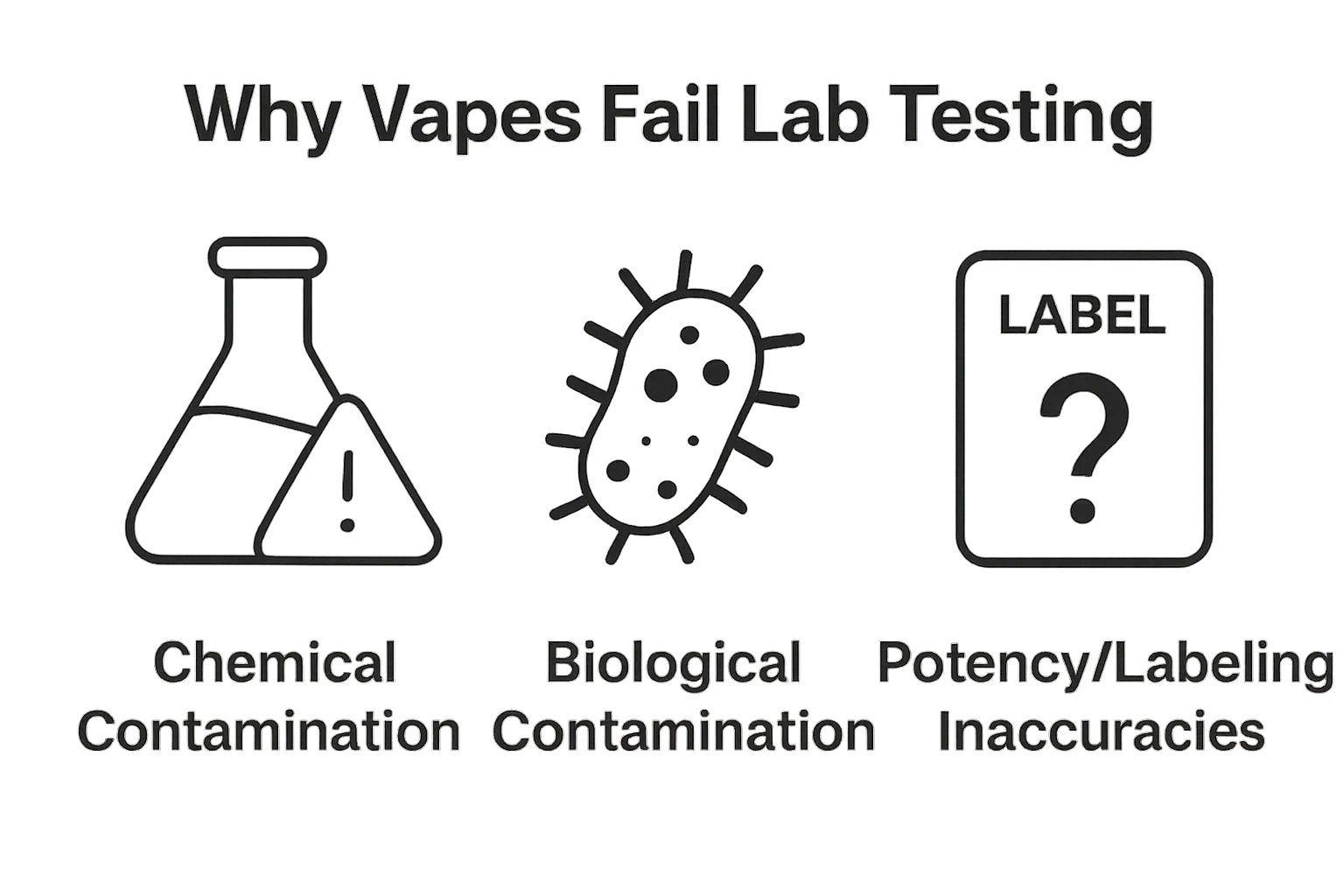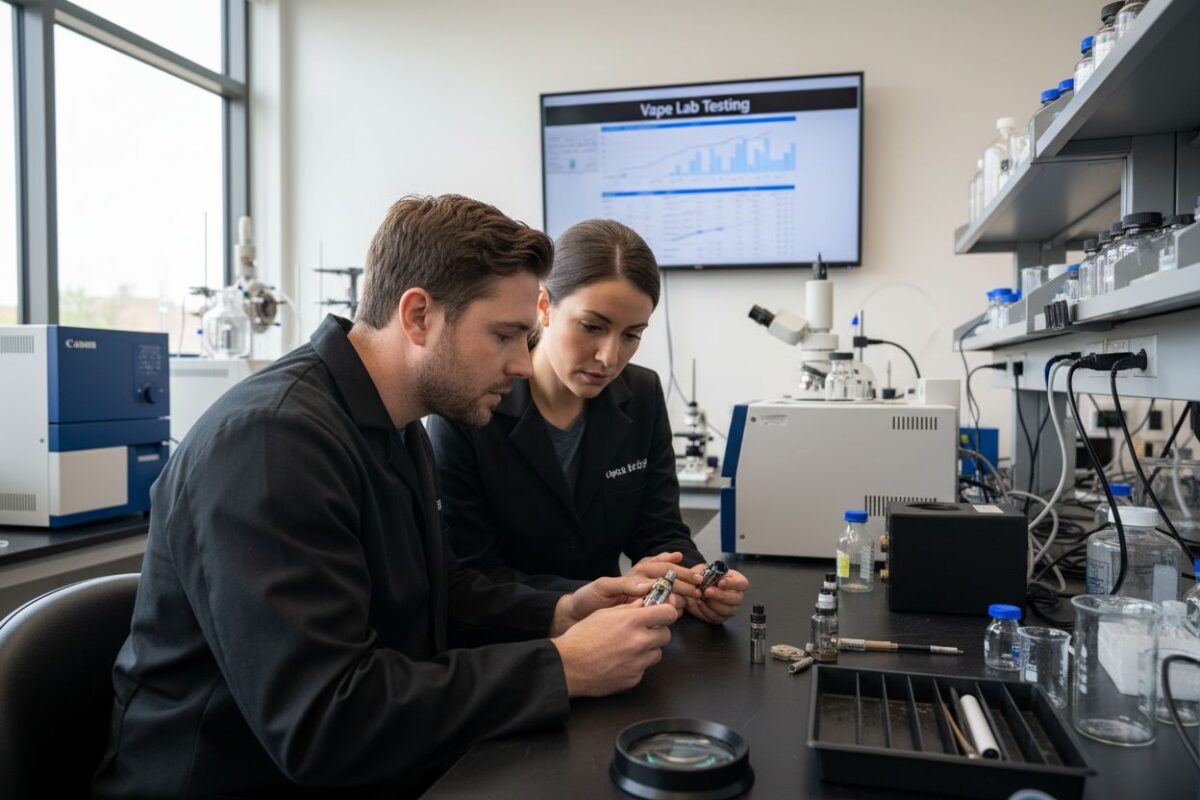Blog
Understanding Why Vapes Fail Lab Testing
Vape lab testing sounds technical, but it shapes what actually reaches your lungs every time you inhale a cannabis vape. Labs do not just skim the surface. Every disposable cartridge goes through a screen for over 100 chemical contaminants, including tests that catch residual solvents, heavy metals, pesticides and bacteria. Most people think the real danger comes from the plant itself. The reality is, it is what gets left behind during manufacturing that is most likely to cause serious harm. What happens inside the lab can make or break product safety and trust.
Table of Contents
- The Basics Of Vape Lab Testing: What Is It?
- Common Reasons For Vape Testing Failures
- The Impact Of Failed Lab Tests On Consumers And Industry
- Understanding Cannabis Concentrates And Quality Control
- Key Concepts In Vape Safety And Regulation
Quick Summary
| Takeaway | Explanation |
|---|---|
| Vape lab testing ensures product safety. | Lab testing detects harmful contaminants and ensures compliance with safety standards to protect consumers. |
| Common testing failures involve contamination. | Chemical and biological contaminants, such as residual solvents and microbial agents, frequently lead to failed tests. |
| Consumer trust hinges on testing transparency. | Accurate lab results and clear labeling are essential for maintaining consumer confidence in cannabis products. |
| Failing tests lead to substantial economic consequences. | Manufacturers face financial losses, recalls, and damage to their reputation if they fail lab tests. |
| Regulations support rigorous safety protocols. | Strict regulatory frameworks outline testing requirements and promote ongoing monitoring to safeguard public health. |
The Basics of Vape Lab Testing: What is it?
Vape lab testing represents a critical quality control process designed to ensure the safety, potency, and compliance of cannabis vaping products before they reach consumers. This comprehensive analytical procedure goes far beyond simple quality checks, serving as a critical safeguard against potential health risks associated with vaporized cannabis concentrates.
Understanding the Core Purpose of Lab Testing
At its fundamental level, vape lab testing involves a rigorous scientific examination of cannabis vape products to detect and quantify various chemical components and potential contaminants. Research from the National Center for Biotechnology Information reveals that these tests screen for multiple critical factors:
- Residual Solvents: Identifying chemical extraction remnants that could be harmful when inhaled
- Heavy Metals: Detecting trace amounts of potentially toxic metallic elements
- Pesticide Residues: Ensuring no dangerous agricultural chemicals remain in the final product
- Microbial Contaminants: Checking for potentially harmful bacteria or fungal elements
Why Lab Testing Matters for Consumer Safety
The significance of comprehensive vape lab testing cannot be overstated. Without thorough scientific analysis, consumers remain vulnerable to products that might contain dangerous substances or inconsistent cannabinoid concentrations. These tests serve as a critical barrier between potentially hazardous materials and the end user.
Lab testing provides multiple layers of protection by establishing standardized quality benchmarks. Trained technicians utilize advanced scientific equipment like gas chromatography and mass spectrometry to perform detailed chemical analyses. These sophisticated techniques allow for precise measurement and identification of substances present in cannabis vape products.
For cannabis enthusiasts interested in deeper insights, our guide on understanding lab testing processes offers comprehensive details about the intricate world of product verification and safety protocols.
Common Reasons for Vape Testing Failures
Vape testing failures represent a critical quality control mechanism that protects consumers from potentially dangerous cannabis products. Understanding the specific reasons behind these failures helps manufacturers improve production processes and ensures safer consumption experiences.
To help you understand the different types of vape contamination and their effects, here is a comparison table summarizing the main sources and associated risks discussed in the article.
| Type of Contamination | Source or Cause | Potential Risk to Consumer |
|---|---|---|
| Residual Solvents | Incomplete extraction process | Harmful chemical inhalation |
| Pesticide Traces | Agricultural chemicals during cultivation | Toxic exposure, allergic reactions |
| Heavy Metals | Manufacturing equipment, extraction equipment | Toxicity, long-term health impacts |
| Microbial Contaminants | Organic nature, improper storage/manufacturing | Infection, respiratory complications |
| Labeling Inaccuracies | Poor quality control during production | Unexpected effects, mistrust |

Chemical Contamination and Extraction Residuals
Research published in Environmental Health Perspectives highlights the significant risks associated with chemical contamination in vaping products. Manufacturers frequently encounter testing failures due to several key contamination issues:
- Residual Solvents: Incomplete extraction processes can leave behind harmful chemical remnants
- Pesticide Traces: Agricultural chemicals used during cannabis cultivation can persist in final products
- Heavy Metal Presence: Manufacturing equipment and extraction processes might introduce toxic metallic elements
Biological Contamination and Microbial Risks
Beyond chemical concerns, biological contamination represents another substantial reason for vape testing failures. Cannabis products are particularly susceptible to microbial growth due to their organic nature. Laboratories screen for potentially dangerous microorganisms that could pose serious health risks to consumers.
The most common biological contaminants include bacteria, mold, and fungal spores. These microorganisms can proliferate during cultivation, storage, or manufacturing processes. Stringent testing protocols aim to detect even minimal traces of these harmful biological agents, ensuring that only the cleanest and safest products reach consumers.
Potency and Labeling Inaccuracies
Testing failures are not exclusively limited to contamination concerns. Inaccurate potency reporting and mislabeled cannabinoid concentrations represent significant issues in the cannabis vaping industry. Consumers expect precise information about THC and CBD levels, and any discrepancy can result in immediate product rejection.
Manufacturers must demonstrate exact alignment between stated product specifications and actual laboratory measurements. This requires sophisticated testing equipment and meticulous quality control processes. Check out our guide on essential lab testing tips to understand how professional cannabis producers maintain rigorous standards.
The Impact of Failed Lab Tests on Consumers and Industry
Lab testing failures in the cannabis vaping industry create profound consequences that extend far beyond immediate product rejection. These failures trigger a complex chain reaction affecting consumer safety, industry reputation, and regulatory compliance.
Consumer Health and Safety Risks
Research from the National Cannabis Industry Association reveals that failed lab tests expose consumers to significant potential health hazards. The immediate risks associated with substandard vape products include:
- Respiratory Complications: Potential exposure to harmful chemical residues
- Long Term Health Impacts: Potential accumulation of toxic substances
- Unknown Substance Interactions: Unpredictable reactions from contaminants
Economic and Regulatory Consequences
Failed lab tests create substantial economic challenges for cannabis manufacturers. When products do not meet stringent safety standards, companies face multiple financial and operational penalties. These often include:
- Mandatory product recalls
- Substantial financial losses from destroyed inventory
- Potential legal sanctions and regulatory fines
- Damage to brand reputation and consumer trust
Market Trust and Industry Reputation
Repeated lab testing failures can devastate an entire company’s market position. Consumers increasingly demand transparency and safety in cannabis products, and any hint of compromised quality can lead to immediate loss of customer confidence. Reputation management becomes critical in an industry where consumer trust is paramount.
Manufacturers must invest in robust quality control processes, advanced testing technologies, and transparent communication strategies.
IMAGE:descriptive_key_1] [Learn more about maintaining rigorous testing standards to understand how professional producers protect their brand integrity and consumer safety.
Understanding Cannabis Concentrates and Quality Control
Cannabis concentrates represent highly potent extracts that demand exceptional quality control measures. Unlike traditional cannabis flower, these products undergo complex extraction processes that can potentially concentrate not just desirable cannabinoids, but also potentially harmful substances.
The following table outlines the major extraction methods for cannabis concentrates, their characteristics, and the key risks as explained in the content.
| Extraction Method | Key Characteristics | Main Risks |
|---|---|---|
| Solvent-Based | Uses chemicals as solvents for extraction | Residual chemical contamination |
| CO2 Extraction | Utilizes CO2 with precise temp/pressure | Requires strict process controls |
| Mechanical Separation | No solvents, physical separation process | Introduction of physical contaminants |
Extraction Methods and Potential Risks
Research published in Cannabis and Cannabinoid Research highlights the critical importance of understanding extraction techniques and their inherent risks. Different extraction methods present unique challenges for quality control:
- Solvent-Based Extraction: Potential residual chemical remnants
- CO2 Extraction: Complex process requiring precise temperature and pressure controls
- Mechanical Separation: Risk of introducing physical contaminants
Chemical Composition and Concentration Dynamics
Concentrates represent significantly more complex products compared to traditional cannabis forms. The concentration process amplifies both beneficial cannabinoids and potential contaminants. Manufacturers must employ sophisticated analytical techniques to ensure:
- Accurate Potency Measurements: Precise THC and CBD content
- Contaminant Screening: Identifying trace chemical compounds
- Consistency in Production: Maintaining uniform product quality
Quality Control Best Practices
Successful quality control for cannabis concentrates requires a multifaceted approach. Advanced laboratories utilize cutting-edge technologies like gas chromatography and mass spectrometry to perform comprehensive product assessments. Rigorous testing protocols become essential in identifying potential risks before products reach consumers.
Learn more about our comprehensive safety standards to understand how professional producers maintain the highest levels of product integrity and consumer safety.
Key Concepts in Vape Safety and Regulation
Vape safety and regulation represent complex frameworks designed to protect consumer health and establish industry standards. These comprehensive guidelines evolve continuously as scientific understanding and technological capabilities advance, creating a dynamic landscape of protection and accountability.
Regulatory Frameworks and Compliance Standards
Research from the Food and Drug Administration underscores the critical importance of rigorous regulatory oversight in the cannabis vaping industry. Key regulatory concepts include:
- Product Ingredient Transparency: Mandatory disclosure of all chemical components
- Manufacturing Process Scrutiny: Detailed documentation of production methods
- Consistent Potency Reporting: Standardized measurement of active compounds
Health and Safety Monitoring Protocols
Regulatory bodies establish comprehensive monitoring protocols to ensure consumer protection. These protocols go beyond simple testing, encompassing a holistic approach to product safety. Manufacturers must demonstrate:
- Comprehensive Chemical Analysis: Screening for potential harmful substances
- Long Term Health Impact Assessment: Evaluating potential cumulative risks
- Continuous Quality Monitoring: Ongoing testing and verification processes
Consumer Education and Risk Mitigation
Effective regulation extends beyond laboratory testing, emphasizing consumer awareness and education. Proactive risk communication becomes a critical component of safety strategies. Manufacturers and regulatory agencies must work collaboratively to:
- Provide clear usage instructions
- Communicate potential health risks
- Establish transparent reporting mechanisms
Learn more about the critical role of education in vape safety to understand how knowledge empowers consumers in making informed choices about cannabis vaping products.
Fail-Free Vaping Starts With Verified Quality
Are you tired of the uncertainty around vape lab testing failures? If you worry about hidden contaminants, inconsistent potency, or mislabeled products—as covered in our article—you are not alone. These pain points can turn what should be a safe and enjoyable experience into a source of stress. With complex terminology like residual solvents, heavy metals, or potency discrepancies, choosing your next vape can feel confusing and risky.

Choose a brand with nothing to hide. At Shorties Disposable, every high-capacity device comes with accessible lab reports, straightforward verification tools, and a firm commitment to your safety. Our transparent authenticity and lab analysis resources make it easy to check what you are inhaling—today, and every time you shop. Take charge of your health and enjoy unforgettable flavors with peace of mind. Shop now for quality you can see and trust at Shorties Disposable.
Frequently Asked Questions
What are the most common reasons for vape testing failures?
The most common reasons for vape testing failures include chemical contamination from residual solvents, pesticide traces, heavy metals, and biological contamination such as bacteria and mold.
How does lab testing improve consumer safety for vape products?
Lab testing improves consumer safety by detecting harmful contaminants, ensuring accurate potency reporting, and verifying that products comply with health and safety regulations before they reach consumers.
What impact do failed lab tests have on consumers?
Failed lab tests can expose consumers to serious health risks, including respiratory complications and long-term health impacts from potentially toxic substances contained in substandard vape products.
How can manufacturers prevent vape testing failures?
Manufacturers can prevent vape testing failures by implementing rigorous quality control processes, utilizing advanced testing technologies, and following best practices in production to ensure consistent product quality.
Recommended
- 8 Essential Tips for Your Lab Testing Checklist – SHORTIES DISPOSABLE VAPE
- Understanding the Role of Lab Testing in Cannabis – SHORTIES DISPOSABLE VAPE
- Why Avoid Untested Cannabis Vapes: Understanding the Risks – SHORTIES DISPOSABLE VAPE
- Understanding What is Vape Leakage and Its Impact – SHORTIES DISPOSABLE VAPE

